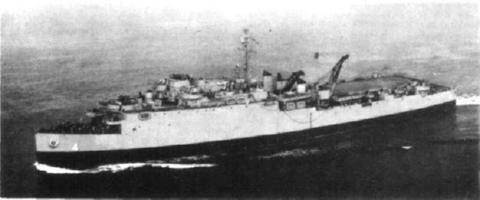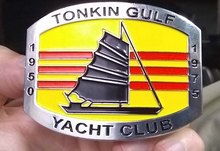 |
|||||||
 |


U.S.S. EPPING FOREST
(LSD-4)MAXIMUS IN MINIMUS
Click to view crew list
USS EPPING FORREST (LSD-4) - an Ashland class dock landing ship
In Commission 1943 to 1968LSD-4 Deployments - Major Events
| Add a LSD-4 Shellback Initiation | Add a LSD-4 Deployment - Major Event | ||||
| Month | Year | to | Month | Year | Deployment / Event |
|---|---|---|---|---|---|
| NOV | 1942 | - | Keel Date: 23 NOV 1942 | ||
| APR | 1943 | - | Launch Date: 2 APR 1943 | ||
| OCT | 1943 | - | Commissioned: 11 OCT 1943 | ||
| JAN | 1944 | - | JAN | 1946 | Luzon |
| FEB | 1944 | - | Shellback Initiation - 8 FEB 1944 - Pacific Ocean | ||
| JAN | 1945 | - | JAN | 1945 | Luzon |
| DEC | 1950 | - | DEC | 1950 | Recommisioned |
| AUG | 1961 | - | OCT | 1968 | transfer permanent new home port to Sasepo Japan |
| MAR | 1963 | - | AUG | 1963 | West Pac-Viet Nam |
| APR | 1963 | - | JUN | 1963 | West Pac-Viet Nam |
| OCT | 1968 | - | Decommissioned: 31 OCT 1968 | ||
LSD-4 General Specifications
Complement: 17 Officers and 237 Enlisted
Displacement: 7930 tons
Length: 457 feet 9 inches
Beam: 72 feet 2 inches
Draft: 8 feet 2 in
Flank Speed: 17 knots
Final Disposition: Sold for scrapping in Japan 30 October 1969
USS EPPING FORREST (LSD-4)
Epping Forest (LSD-4) was launched 2 April 1943 by Moore Dry Dock
Co.
Oakland
Calif.; sponsored by Mrs. J. H. Heintz
and commissioned 11
October 1943
Lieutenant Commander L. Martin
USNR
in command.
Epping Forest sailed from San Diego 13 January 1944
with marines
on board for training in the Hawaiian Islands. She cleared Maui 22 January
combat-loaded for the invasion of the Marshalls
and sent men and artillery-laden
landing craft ashore in the initial assaults on Roi and Namur 31 January.
After replenishing at Funafuti early in February
Epping Forest sailed
to Tulagi
where alterations were made
and she loaded men and equipment
of the 1st Marines. These she landed in the assault on Emirau 20 March.
During the next 3 weeks
Epping Forest brought reinforcements and supplies
in to Emirau from Guadalcanal and Manus
and on 10 April
arrived at Finschhafen
to prepare for the Hollandia operations.
Epping Forest arrived off Aitape 22 April 1944 for preinvasion bombardment
then sent her landing craft ashore in the assault and returned to Finschhafen
to reload. She shuttled supplies to Aitape and Hollandia and repaired landing
craft at Buna
and on 11 May reached Guadalcanal to load marines and their
equipment for the invasion of Guam. After standing by in reserve during
the invasions of Tinian and Saipan
she arrived off Guam 21 July for the
assault landings. For 5 days she lay off the island repairing landing craft
and then returned to Guadalcanal
from which she made several voyages to
Manus transporting landing craft through August.
Epping Forest brought her specialized facilities into play once more
in the invasion of the Palau Islands
Iying off Peleliu to repair landing
craft after the assault of 15 September 1944. After staging at Hollandia
she joined in the initial assault in Leyte Gulf 20 October
landing engineering
troops and their equipment
and sailing immediately to Hollandia to reload.
She continued to voyage between New Guinea and Leyte with men and gear into
December
then prepared for the Lingayen Gulf assault.
On 9 January 1945
Epping Forest sent her boats away in the assault
of Lingayen Gulf
working under almost constant air attack. The next day
she got underway for Morotai to reload Army equipment
with which she returned
to Lingayen 27 January. For 2 weeks she repaired landing craft here
then
put into Leyte on her way to transfer landing craft from Saipan to Guam
and again from Milne Bay to Leyte
arriving 13 March to prepare for the
Okinawa assault.
Epping Forest arrived off the Hagushi beaches 1 April 1945 for the
invasion of Okinawa
and during the days of bitter fighting
repaired landing
craft at various anchorages around the island. She worked with the skill
of long practice under air attacks and the constant threat of enemy suicide
attacks by small boats and swimmers as well as aircraft. On 1 July she sailed
for Portland Oreg.
arriving 25 days later. After carrying landing craft
along the west coast and to the Hawaiians
she brought a load of small craft
to Bikini in June 1946 for use in Operation "Crossroads
" the
atomic weapons tests and returned to San Diego 27 June. She was decommissioned
and placed in reserve at Long Beach 25 March 1947.
Epping Forest was recommissioned 1 December 1950 and sailed along
the west coast for training until 2i May 1951
when she departed San Diego
for the troubled Far East.
Operating in support of UN forces until 7 February 1952
she returned to
the west coast for local training and exercises. From October 1952 to September
1953 she again deployed to the waters off Korea where she supported minesweeping
operations in Wonsan harbor
the first such use of an LSD.
Epping Forest underwent overhaul in November 1953 and resumed her
station in the Far East during the following April. She participated in
amphibious operations at Okinawa and Korea
transported the refugees of
French Indo-China in the "Passage to Freedom" mission during the
summer of 1954 and engaged in exercises off the Japanese coast.
Her tour of Far Eastern waters in 1955-56 was devoted to local operations.
In August 1957
she again departed San Diego to engage in the 7th Fleet
Operation "Phiblink" in which she won special recognition for
her performance. Following fleet exercises in the South China Sea
she returned
to San Diego in April 1958 for a period of yard availability.
Coastal operations preceded her return to the western Pacific in June 1959
to provide transportation and support to a division of minesweeping craft.
During the Laotian crisis she joined Amphibious Squadron One at Okinawa
in a state of combat readiness for any eventuality.
Epping Forest returned to the States in November 1959 for another
period of overhaul and upkeep. Assigned to the control of Mine Forces
Pacific
she was ordered to a new homeport
Sasebo
Japan
whence she sailed on 22
August 1960 prior to offloading quantities of supplies for Operation "Hand
Clasp" in Korea. During the remainder of the year she cruised as flagship
of Commander
Mine Flotilla One
and took part in mine countermeasure exercises.
[Note: The above USS EPPING FORREST (LSD-4) history may or may not contain text provided by crew members of the USS EPPING FORREST (LSD-4) or by other non-crew members and text from the Dictionary of American Naval Fighting Ships]
